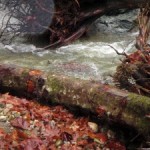Contact: Steve Robinson
(360) 951-2494
syəcəb
Contact: Steve Robinson
(360) 951-2494

Northwest Indian Fisheries Commission, http://nwifc.org
The Stillaguamish Tribe recently partnered with the state Department of Natural Resources Family Forest Fish Passage Program to restore access to Cherokee Creek, near Darrington.
Cherokee Creek provides spawning, rearing and refuge for coho and other species of Pacific salmon, as well as cutthroat and bull trout. However, the creek also was home to a deteriorating metal culvert that had been poorly installed and was too small to withstand floods.
“The culvert had created an artificial waterfall that was too high for salmon to swim or jump past on their way upstream,” said Scott Rockwell, Forest and Fish biologist for the tribe. “It was also interfering with natural stream ecology, interrupting the downstream movement of water, fallen trees and gravel.”
The Family Forest Fish Passage Program replaced the culvert with a steel bridge and an 80-foot-long section of stream channel that restored fish access to more than a mile of productive spawning habitat. The state program helps small forest landowners comply with forest practice rules by covering 75-100 percent of the cost of eliminating stream barriers.
At a fall event celebrating the project’s completion, many coho salmon swam through the restored area.
“Their genetic compasses guided them back to habitat that had not been accessible for years,” said Washington State Forester Aaron Everett, who worked on the project.
As a project sponsor, the Stillaguamish Tribe conducted landowner outreach, collected habitat data, provided matching project funds, and managed project design, construction oversight, permitting and billing.
Cherokee Creek is a spawner index stream for coho salmon. For the past 12 years, Stillaguamish natural resources staff have documented the number and location of spawning adults and redds (egg nests) to help forecast the size of future coho runs.
For more information about the state’s Small Forest Landowner Office, visit www.dnr.wa.gov/sflo.